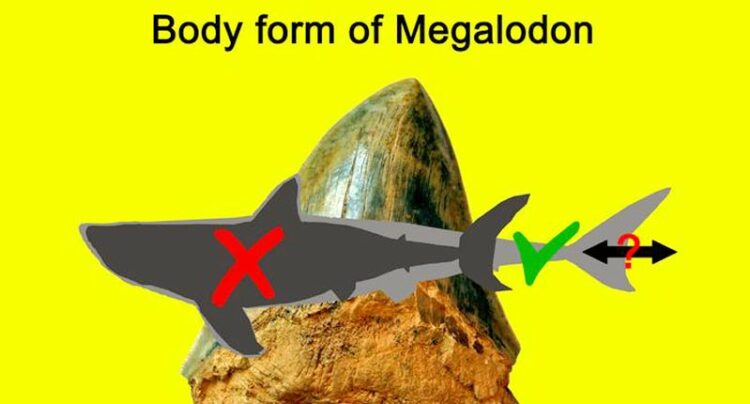Slender shark: Study finds Megalodon was not like a gigantic great white shark

A dark grey silhouette depicting the previously reconstructed Otodus megalodon body form based largely on the modern white shark, superimposing a light grey outline showing the newly interpreted body form. Important note: The exact extent of body elongation, the shape of the head, and the outline and position of each fin remain unknown based on the present fossil record.
Credit: DePaul University/Kenshu Shimada
Kenshu Shimada at DePaul University co-authors research with 26 shark experts.
A new scientific study shows that the prehistoric gigantic shark, Megalodon or megatooth shark, which lived roughly 15-3.6 million years ago nearly worldwide, was a more slender shark than previous studies have suggested.
Formally called Otodus megalodon, it is typically portrayed as a super-sized, monstrous shark in novels and sci-fi films, including “The Meg.” Previous studies suggest the shark likely reached lengths of at least 50 to 65 feet (15 to 20 meters). However, O. megalodon is largely known only from its teeth and vertebrae in the fossil record. Thus, the modern great white shark (Carcharodon carcharias) has traditionally been used as a model for the body form of O. megalodon in previous studies.
The new study published in the journal “Palaeontologia Electronica,” however, illuminates that O. megalodon had a body form that was more elongated than the modern great white shark. “The remarkably simple evidence that O. megalodon had a more slender body than the great white shark was hidden in plain sight,” said Kenshu Shimada, DePaul University paleobiology professor, a co-leader and the senior author of the new study.
A previously described, incomplete set of fossil vertebrae from an O. megalodon individual was reported to be 11.1 m in total combined vertebral length. However, the exact same fossil individual was estimated to be only 9.2 m in total length, including the head, in yet another previous study extrapolated from the quantitative relationship between the diameters of the largest vertebrae and body lengths measured from multiple modern great white sharks. “It was a ‘eureka-moment’ when our research team realized the discrepancy between the two previously published lengths for the same Megalodon specimen,” added Shimada.
“The new study strongly suggests that the body form of O. megalodon was not merely a larger version of the modern great white shark,” noted the other co-leader Phillip Sternes, who studied with Shimada and earned his master’s degree from DePaul. Sternes, the first author of the study, is now a Ph.D. candidate at the University of California, Riverside.
“Even though it remains uncertain exactly how long the body of O. megalodon was elongated relative to the great white shark, this new finding marks a major scientific breakthrough in the quest to decipher what Megalodon looked like,” described Sternes.
The research team of the new study consists of 26 shark experts including Sternes and Shimada, representing 29 academic institutions around the globe, including the U.K., Austria, Italy, Japan, Mexico, Brazil, France and Australia, as well as the U.S. The international team also includes Jake Wood, who was also one of Shimada’s master’s students.
“Moving forward, any meaningful discussion about the body form of O. megalodon would require the discovery of at least one complete, or nearly complete, skeleton of the species in the fossil record,” noted Wood.
“Despite the major scientific advancement in our new study, the fact that we still don’t know exactly how O. megalodon looked keeps our imagination going,” Shimada said. “The continued mystery like this makes paleontology, the study of prehistoric life, a fascinating and exciting scientific field.”
The new study, “White shark comparison reveals a slender body for the extinct megatooth shark, Otodus megalodon (Lamniformes: Otodontidae),” will appear in the forthcoming issue of Palaeontologia Electronica, which will be freely available online at https://doi.org/10.26879/1345. It is authored by: Phillip Sternes, Patrick Jambura, Julia Türtscher, Jürgen Kriwet, Mikael Siversson, Iris Feichtinger, Gavin Naylor, Adam Summers, John Maisey, Taketeru Tomita, Joshua Moyer, Timothy Higham, João Paulo da Silva, Hugo Bornatowski, Douglas Long, Victor Perez, Alberto Collareta, Charlie Underwood, David Ward, Romain Vullo, Gerardo González-Barba, Harry Maisch IV, Michael Griffiths, Martin Becker, Jake Wood, and Kenshu Shimada. This work was partially supported by a U.S. National Science Foundation grant (Award Number 1830858) and DePaul University’s University Research Council Competitive Research Grant awarded to Kenshu Shimada.
Journal: Palaeontologia Electronica
DOI: 10.26879/1345
Article Title: White shark comparison reveals a slender body for the extinct megatooth shark, Otodus megalodon (Lamniformes: Otodontidae)
Article Publication Date: 22-Jan-2024
All latest news from the category: Life Sciences and Chemistry
Articles and reports from the Life Sciences and chemistry area deal with applied and basic research into modern biology, chemistry and human medicine.
Valuable information can be found on a range of life sciences fields including bacteriology, biochemistry, bionics, bioinformatics, biophysics, biotechnology, genetics, geobotany, human biology, marine biology, microbiology, molecular biology, cellular biology, zoology, bioinorganic chemistry, microchemistry and environmental chemistry.
Newest articles

First-of-its-kind study uses remote sensing to monitor plastic debris in rivers and lakes
Remote sensing creates a cost-effective solution to monitoring plastic pollution. A first-of-its-kind study from researchers at the University of Minnesota Twin Cities shows how remote sensing can help monitor and…

Laser-based artificial neuron mimics nerve cell functions at lightning speed
With a processing speed a billion times faster than nature, chip-based laser neuron could help advance AI tasks such as pattern recognition and sequence prediction. Researchers have developed a laser-based…

Optimising the processing of plastic waste
Just one look in the yellow bin reveals a colourful jumble of different types of plastic. However, the purer and more uniform plastic waste is, the easier it is to…



